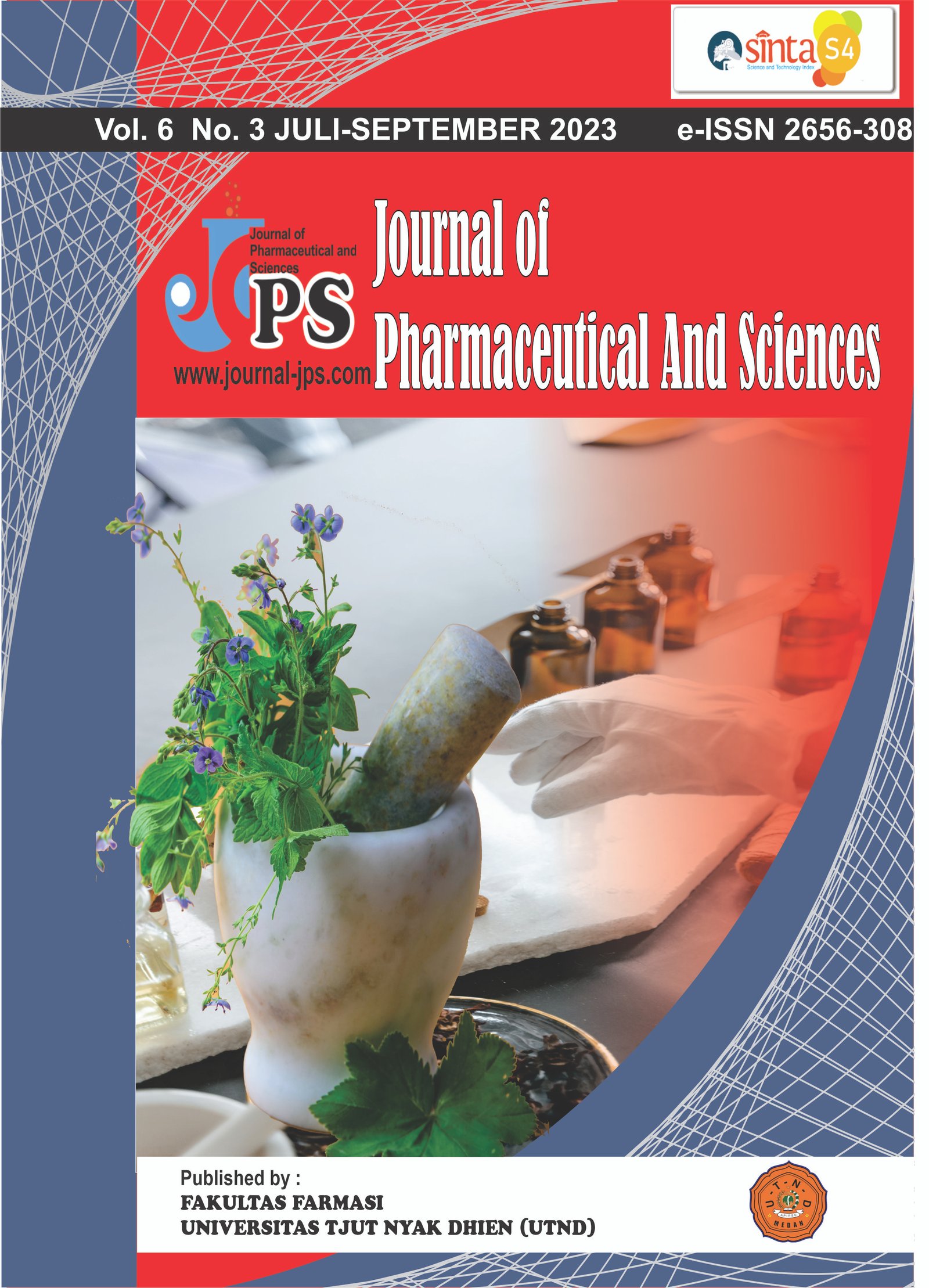Standarisasi parameter spesifik dan non spesifik ekstrak etanol tanaman sambiloto (Andrographis paniculata. Burm.f) sebagai obat herbal terstandar
Main Article Content
Page: 1086-1091
Abstract
This study's objective is to ascertain how to make Sambiloto simplicia that is good and right according to the second edition of the 2017 herbal pharmacopoeia standards, to find out non-specific and specific parameters, which consist of tests for water content, ash content, drying shrinkage, water-soluble extract content, and extract content. Soluble ethanol in Sambiloto simplicia and knowing the secondary metabolites of Sambiloto simplicia. This study employed a qualitative and quantitative observational methodology. The research object was the Sambiloto plant (Andrographis paniculata. Burm.f) which was planted within the home's yard in the Sungai Lekop Plot, Sungai Lekop Village, Sagulung District, Batam City. The results showed that Sambiloto extract contains secondary metabolites of tannins, alkaloids, saponins, terpenoids and flavonoids. Sambiloto viscous extract obtained by 5 ml from 500 ml extract parameter values for non-specific and specific test water content of Sambiloto is 9%, drying shrinkage is 18.5%, total ash content is 10%, water-soluble extract is 12.96%, and ethanol-soluble extract 8%, specific and non-specific parameter tests met the requirements for the 2017 herbal pharmacopoeia, the results showed that Sambiloto simplicia fulfilled the requirements as a standardized herbal medicine.
Downloads
Article Details

This work is licensed under a Creative Commons Attribution-NonCommercial-ShareAlike 4.0 International License.
References
Ciulei, J. 1984. Metodology for Analysis of vegetable and Drugs. Bucharest Rumania: Faculty of Pharmacy
Depkes RI. 1995. Farmakope Indonesia. Edisi IV. Jakarta: Departemen Kesehatan Republik Indonesia
Depkes, 2000. Parameter Standard Umum Ekstrak Tumbuhan Obat, cetakan pertama, Direktorat Jendral Pengawasan Obat dan Makanan, Jakarta
Dhami, N. (2013). "Trends in Pharmacognosy: A modern science of natural medicines". Journal of Herbal Medicine. 3 (4): 123–131
Farmakope herbal indonesia. 2017. Kementerian Kesehatan RI. Jakarta. ISBN: 978-602-416-329-7. 378-382
Farnsworth, N.R. 1966. Biological and Phytochemical Screening of Plants. J. Pharm. Sci 55.
Grassi D. dkk. 2010. Flavonoids: Antioxidants Against Atherosclerosis. Nutrients. 2: 889-902
Halimah, 2010. Uji Fitokimia dan Uji Toksisitas Ekstrak Tanaman Anting-Anting (acalypha indica Linn) Terhadap Larva Udang (Artemia salinaLeach). Skripsi . Jurusan KimiaFakultas Sains dan Teknologi. Universitas Islam Negri Maulana Malik Ibrahim, Malang.
Hayati R, Abdullah A, Ayob M, Soekarto S. 2005. Analisis Kadar Air dan Aktivitas Air Kritikal Produk Sata dari Malaysia dan Implikasinya pada Sifat-sifat Produk dan Umur Simpannya. Jurnal Teknologi dan Industri Pangan 16 (3) : 191.
Sitorus, R. M., & Azzahra, S. F. (2017). Analisis Fitokimia Bagian Daun Sambiloto (Andrographis Paniculata).
Knight, A.P. & R.G. Walter. 2004. Plants Associated with Congenital Defects and Reproductive Failure. In: A Guide to Plant Poisoning of Animals in North America, A.P. Knight and R.G. Walter (Eds.) Publisher: Teton NewMedia,
Kraus T. E. C., Dahlgren R. A., Zasoski R. J. (2003a). Tannins in nutrient dynamics of forest ecosystems–a review. Plant Soil 256, 41–66.10.1023/A:1026206511084
Lenny Sofia. 2006. Senyawa terpenoida dan steroida. departemen kimia FMIPA. FMIPA Universitas Sumatra Utara. Medan
Markham, K. R., 1988. Cara Mengidentifikasi Flavonoid. Bandung: Penerbit ITB. Hal.5,10
Pieroni A, Quave C, Nebel S, HenrichM 2002. Ethnopharmacy of the Ethnic Albanians (Arbereshe) of Northern Basilicata. Italy (IT). Fitoterapia. 72:217-241.
Seidel. V, 2006. Initial and bulk extraction. in: Sarker SD, Latif Z, & Gray AI, editors. Natural Products Isolation. 2nd ed. Totowa (New Jersey). Humana Press Inc. hal. 31-5.
Sembiring, Br, Bagem. 2005. Status Teknologi Pasca Panen Sambiloto (Andrographis paniculata Needs). Balai Penelitian Tanaman Obat dan Aromatik.





